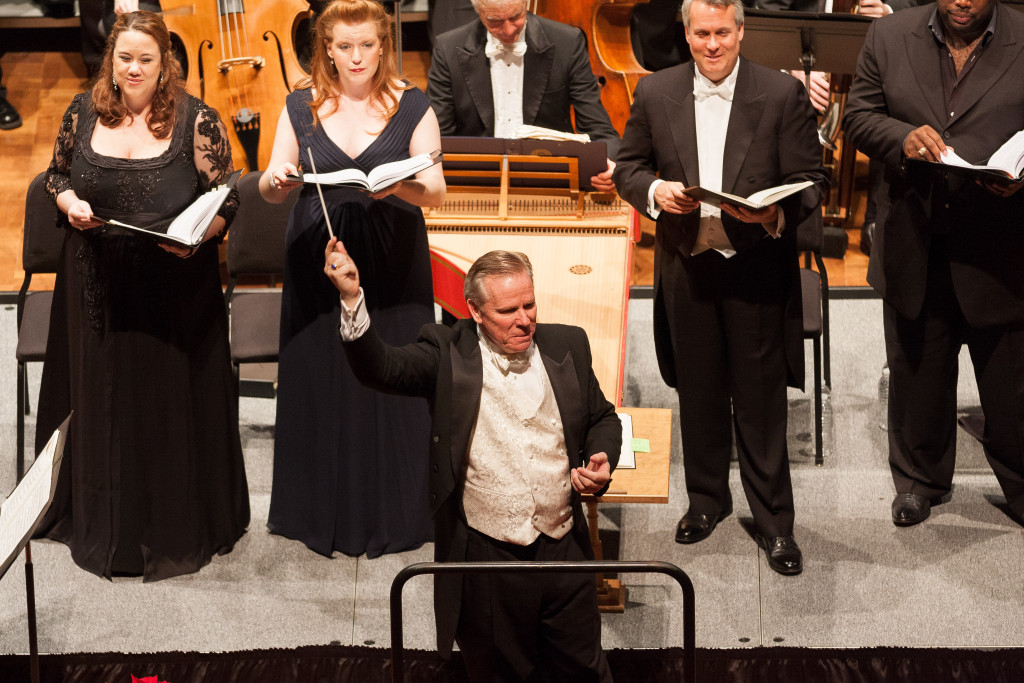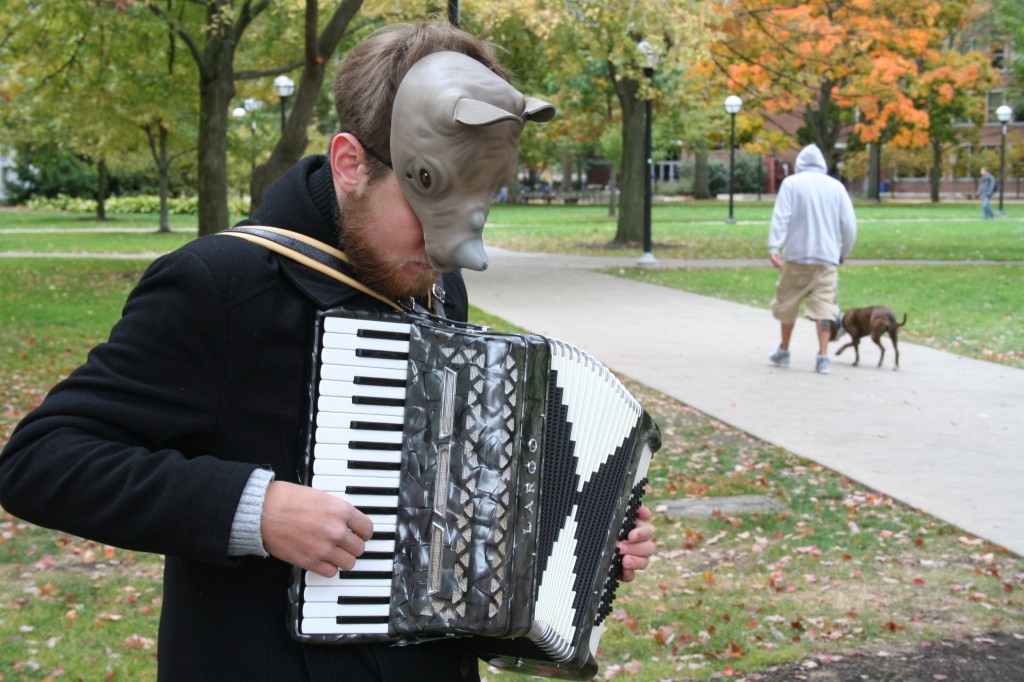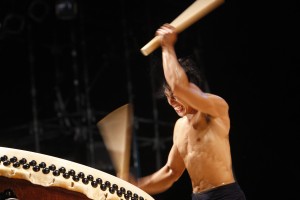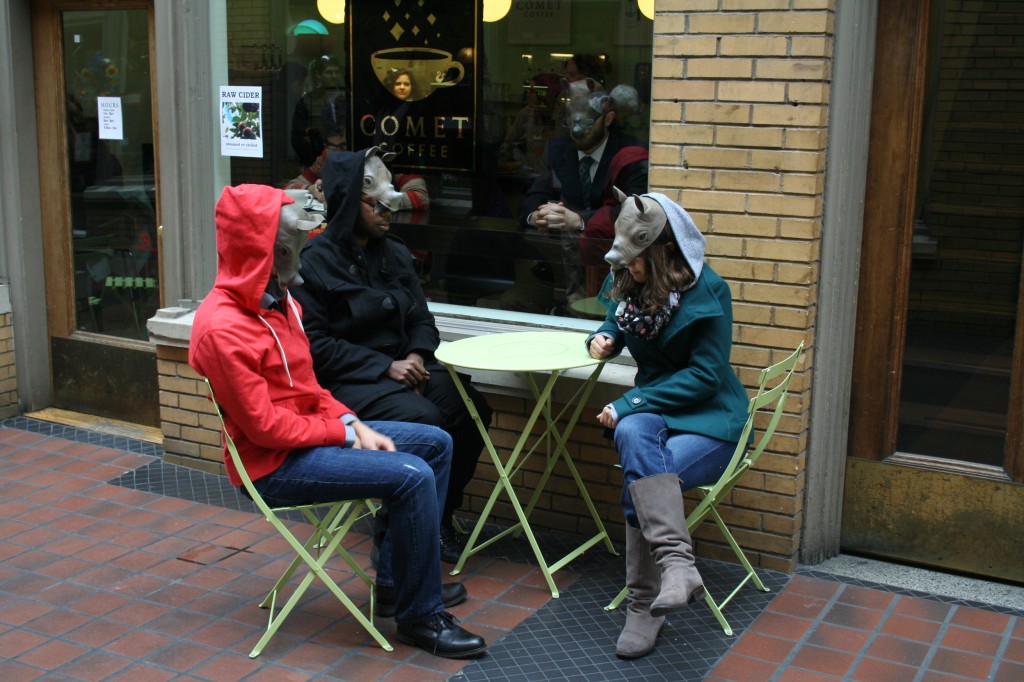Outgoing UMS Choral Union Music Director and Conductor Jerry Blackstone Inspires $100,000 Gift
 On Monday July 6, Jerry Blackstone, Director of Choirs and Chair of the Conducting Department at the University of Michigan, claimed the podium one last time as the UMS Choral Union Music Director and Conductor to lead singers in a reading of Francis Poulenc’s Gloria as part of the choir’s community music-making sessions entitled Summer Sings. A beloved Ann Arbor tradition, Summer Sings events bring together singers from all over the region to learn and sing together for one evening under the baton of some of our nation’s finest choral conductors. At the close of Poulenc’s monumental piece, participants basked in a moment of awe-inspired silence before erupting into appreciative applause for the timeless music, the memorable experience of singing together, and most importantly, for the work of Jerry Blackstone.
On Monday July 6, Jerry Blackstone, Director of Choirs and Chair of the Conducting Department at the University of Michigan, claimed the podium one last time as the UMS Choral Union Music Director and Conductor to lead singers in a reading of Francis Poulenc’s Gloria as part of the choir’s community music-making sessions entitled Summer Sings. A beloved Ann Arbor tradition, Summer Sings events bring together singers from all over the region to learn and sing together for one evening under the baton of some of our nation’s finest choral conductors. At the close of Poulenc’s monumental piece, participants basked in a moment of awe-inspired silence before erupting into appreciative applause for the timeless music, the memorable experience of singing together, and most importantly, for the work of Jerry Blackstone.
After 12 years of dedicated service as the UMS Choral Union Music Director and Conductor, Blackstone passed the baton to Scott Hanoian, whose appointment as the new leader of the UMS Choral Union began on July 1. In recognition of Blackstone’s service and incredible impact on the choir, the Jerry Blackstone UMS Choral Union Performance Fund was announced at Monday evening’s Summer Sings. Two anonymous donors, who wished to provide the UMS Choral Union membership with opportunities to perform an expanded repertoire of significant choral works, made gifts totaling $100,000 to establish the fund, which will be used to help pay for expenses related to the self-produced concert activities of the UMS Choral Union.
“The 175 volunteer musicians in the UMS Choral Union dedicate considerable time and talent for the benefit of our community. We are delighted to have a fund that will help enhance their experience through a robust season of choral repertoire,” said President Kenneth C. Fischer. “Jerry Blackstone has shown us that great music-making requires more than incredible technique and talent. It requires hard-work, thoughtful reflection, and a supportive community where musicians can be nurtured to see their fullest potential. The Jerry Blackstone UMS Choral Union Performance Fund recognizes the work of a beloved music director and paves the way for exciting projects to come.”
The fund is extended to all UMS Choral Union projects beyond UMS’s annual presentation of Handel’s Messiah that are not performed in partnership with a touring orchestra as part of UMS’s Choral Union Series or scheduled through the Detroit Symphony Orchestra as part of their concert series at Orchestra Hall.
Recent self-produced UMS Choral Union concerts include the 2015 presentation of Mendelssohn’s Elijah, the 2014 presentation of Brahms’s German Requiem, and the 2004 presentation of William Bolcom’s Songs of Innocence and of Experience, the Naxos recording that won three 2006 Grammy Awards (“Best Choral Performance,” “Best Contemporary Classical Composition,” and “Best Classical Album”).
In a recent interview, Karen Isble, Assistant Vice President for Development at the University of Michigan and longtime UMS Choral Union member, said of Blackstone: “Jerry has fostered the Choral Union community. His ability to be so musical and so warm and so inviting to everyone at every musical level really made the difference during his term as the music director.”
While the donors responsible for the Jerry Blackstone UMS Choral Union Performance Fund prefer to remain anonymous, they released the following statement about their gift: “Our hope is that this gift, and the naming of the fund in Jerry Blackstone’s honor, will encourage others who cherish choral music to add to the fund.”
While the end of an era is always bittersweet, the choir turns its eye to a promising future with incoming UMS Choral Union Music Director and Conductor Scott Hanoian, making his first public appearance in the new role at the next Summer Sings event on August 3 to lead a reading of Carl Orff’s Carmina Burana.
“Jerry Blackstone was a hugely influential teacher to me during my time as a music student at the University of Michigan and I’m honored to continue the tradition of great choral music-making in Ann Arbor, “ says Scott Hanoian. “The Jerry Blackstone UMS Choral Union Performance Fund will allow the choir to embark on the next chapter of our storied history. I can’t wait to see what will happen next.”
Donors interested in contributing to the Jerry Blackstone UMS Choral Union Performance Fund can do so online or connect with UMS Associate Director of Development Susie Bozell Craig at sbozell@umich.edu.
Rhino as Participant
Utilizing the expertise and enthusiasm of odd-toed herbivores in the family Rhinocerotidae to invite participatory experiences with the performing arts.
We all have work heroes. Someone our career-selves aspire to be, someone whose philosophies resonate with us on a personal and a professional level. My work hero happens to be Nina Simon, author of The Participatory Museum.
Nina’s philosophy, paraphrased Truly-style, is this: if a cultural institution wants to maintain relevancy, it has to stop treating audience members as passive faces in the crowd and start inviting and utilizing community collaboration, participation, and expertise.
Every community member has something special to bring to the table — be it a doctoral thesis or a really great Netflix recommendation — and thanks to social media, we’ve all grown accustomed to sharing. Simply put: cultural experiences that “stick” for many of us are those that allow us to do something hands-on.
So what does this mean for UMS? It means the umsLOBBY. It means Tweet Seats. It means UMS Night School. It means the UMS Student Committee. It means Rhinos.
 In order to understand the Rhino Project, you’ve got to get to know the UMS Student Committee. An official University of Michigan Student Organization, this committee works tirelessly to promote student engagement in the performing arts on campus. Comprised of roughly 30 student volunteers, UMS works closely with this group to plan and execute our student Arts & Eats events, design and create UMS advertisements and represent UMS to the student population in a variety of other ways.
In order to understand the Rhino Project, you’ve got to get to know the UMS Student Committee. An official University of Michigan Student Organization, this committee works tirelessly to promote student engagement in the performing arts on campus. Comprised of roughly 30 student volunteers, UMS works closely with this group to plan and execute our student Arts & Eats events, design and create UMS advertisements and represent UMS to the student population in a variety of other ways.
This October (11-13), UMS presented the Parisian theater company, Théâtre de la Ville, performing Ionesco’s Rhinocéros. If you didn’t have the pleasure of seeing this production at the Power Center while it was in town, the play was influenced by Ionesco’s time in Romania as a young man, when nearly everyone around him converted to fascism. Being the theater of the absurd classic that it is, replace “fascist” with “rhino” and you’ve got Rhinocéros.
The UMS Student Committee really got behind the concept of a real-life rhino occupation. Equipped with rhino masks and flyers, students took to the streets and for the two weeks leading up to the Théâtre de la Ville performance, rhinos invaded Ann Arbor.
My favorite part of this project was watching the students really run with the idea and take it to entirely new levels. During the campaign, students became actors, buskers, art directors, photographers, and social media animals. Using their expertise and natural enthusiasm, the UMS Student Committee took the campaign and really made it their own.
Sure, the campaign worked for UMS on a purely promotional level but more importantly it invited deep, meaningful participation and collaboration from the students on campus. This is the kind of project that might even make Nina Simon proud. Plus, Théâtre de la Ville loved it. The actors clamored for souvenir rhino hats and the management requested images of our rhinos to be used in company communications efforts.
Rheme Sloan, UMS Student Committee President, did a fabulous job of getting buy-in for the campaign from the students and organizing the efforts on campus. UMS Marketing Intern Anna Piotrowski did a great job of rhino-acting herself and organizing other layers of the rhino campaign, including postering and sidewalk stenciling.
Here, Rheme and Anna talk about what it was like to be a rhino and what this type of participatory project means for student engagement.
UMS: Please introduce yourself. What’s your role at UMS? What interests in you in performing arts?
Rhemé Sloan: I am a junior Voice Performance Major in the School of Music, Theatre, & Dance. I am a Marketing Intern for UMS as well as the President of the UMS Student Committee. I live for the performing arts. They challenge me to think outside of my own world and explore the beauty in all things.
Anna Piotrowski: My name is Anna Piotrowski, and I’m a junior Violin Performance Major with a Performing Arts Management Minor at U-M. This is my first year as a marketing intern at UMS. Since I have been playing the violin for 15 years, I definitely have a passion for the performing arts. I’ve always enjoyed going to a variety of concerts and performances where I can see or hear something that I’ve never encountered before.
UMS: Could you describe your role in the recent Rhinoceros guerrilla marketing campaign?
RM: I was in charge of organizing all the volunteers who went around Ann Arbor and U-M in rhino masks. At several happenings we had photographers come out and take pictures so it was crucial to make sure we had solidified plans. I also organized and participated in the photo shoot that took place at landmarks across central campus. We had a blast taking those photos.
AP: I was in charge of creating a “street team” of 10 people to cover the campus sidewalks with spray chalk Rhinoceroses, as well as getting volunteers to post different flyers promoting the performance. We had a political style campaign poster as well as a traditional informational poster that were posted.
UMS: What did you like about this campaign? What were some surprises along the way?
AP: I liked the mystery behind this campaign – the Rhino masks and spray chalk stenciling and vague political posters were all very attention getting and got people talking! I also liked that it was accompanied with other tactics that were more informational, so people could really get a sense for what type of performance this would be.
RM: I loved how innovative and weird the campaign was. When my supervisor first told me about this project I’m sure my face read “You all must be out of your mind.” But when I saw the posters I was filled with glee because I had never seen anything like it. The biggest surprise along the way was the Saturday morning we did the photo shoot around campus. We had finished taking pictures in Nickels Arcade and were walking across the street to take pictures with this guy playing the accordion. To our disbelief this random accordion player was wearing a rhino mask and had our “Rhino is Listening” flyers in his money box. We couldn’t believe what was happening.
UMS: What kind of a response did you get from other students about this campaign or the performance?
AP: Other students seemed to be excited and willing to participate in this campaign. There were many different ways that students could help out and I think that everyone found something they could enjoy.
RM: Students responded positively to the rhino campaign. We did our best to make Rhino as visible across campus as we possibly could and I think we were very successful. Once the tour came to town there was so much hype around the show and students’ expectations were very high. I think the show really rose to the occasion and many found it very relevant during this election season.
UMS: Did you have the chance to go to the performance? If yes, did working on this campaign affect your experience of the performance?
AP: I did see the performance, and working on the campaign definitely affected how I experienced the performance. It gave me background knowledge of the plot and history of the play, among other things. Working on the campaign also allowed me to go into the performance with a good basic knowledge of what to expect in terms of style, genre, and themes, while still retaining a level of uncertainty as to how it will be delivered. Over all, working on the campaign was a positive contribution to my viewing experience.
RM: I went to the last performance of Rhinocéros. Having worked on the campaign I knew to expect something incredible and major and the show totally delivered. It was difficult to get a full grasp of the play since I was hearing it for the first time in French, but the action and storytelling was so on point that it didn’t matter. Now all I have to do is read it in English!
Check out the November issue of The Ann Magazine for more on this campaign!
Did you see rhinos around town? Would you like to see more campaigns like this one?
Septeto Nacional’s Dance Party Extravaganza
With a rich history firmly rooted in the dance floor explosion of son that took place in the 1920s and 30s, Septeto Nacional de Ignacio Piñeiro de Cuba have been hailed as the “inventors of salsa” (The New York Times) and “national treasures” (The Boston Globe). The band certainly got the audience moving when they played Hill Auditorium on April 7, 2011. And thanks to some pre-show instruction from the University of Michigan’s M-Salsa team, some of us actually had some fancy footwork to flaunt. Take a peek at M-Salsa’s mini-lesson, which took place at one of our pre-show U-M student events, Arts & Eats, and see if you can’t pick up some sassy moves of your own.
Three patrons, three perspectives: The Cripple of Inishmaan
The Cripple of Inishmaan opened at the Power Center last night to rave reviews in the press and in the audience. Here, three distinct voices — a theater critic, a drama professor, and a student — give three distinct perspectives on the play. Read on for what they have to say and tell us: what did you think?
 SALLY MITANI, THEATER CRITIC: To tell you the truth, I was all set to write something else. When you know you’re going to go ablogging at 11 p.m., it helps to have thought of a few possible directions ahead of time. But The Cripple of Inishmaan just surprised me with its straightforward simplicity and sweetness, so I tore up the notes. I’d never seen any of Martin McDonagh’s plays before but I’d read a bit about him and thought I’d caught his drift—edgy, ironic, the kind of guy that is a little scared to be caught looking like a sap. Scan his wiki and you’ll see: dark comedy, blah blah, black comedy, blah blah, ironic, black, dark, blah blah, works with Tom Waits and Christopher Walken. Check. Not that I have anything against this strain of art, but Cripple isn’t it. (Note to self: never use the phrase “dark comedy” again. Its currency has apparently been weakened to include anything that is sad and funny at the same time. At this rate we’ll be calling all of Chekhov a black comedy.)
SALLY MITANI, THEATER CRITIC: To tell you the truth, I was all set to write something else. When you know you’re going to go ablogging at 11 p.m., it helps to have thought of a few possible directions ahead of time. But The Cripple of Inishmaan just surprised me with its straightforward simplicity and sweetness, so I tore up the notes. I’d never seen any of Martin McDonagh’s plays before but I’d read a bit about him and thought I’d caught his drift—edgy, ironic, the kind of guy that is a little scared to be caught looking like a sap. Scan his wiki and you’ll see: dark comedy, blah blah, black comedy, blah blah, ironic, black, dark, blah blah, works with Tom Waits and Christopher Walken. Check. Not that I have anything against this strain of art, but Cripple isn’t it. (Note to self: never use the phrase “dark comedy” again. Its currency has apparently been weakened to include anything that is sad and funny at the same time. At this rate we’ll be calling all of Chekhov a black comedy.)
So forget “dark comedy,” whatever that means. It’s a sweetly brutal play about a small bunch of goofballs and gossips on a desolate, windswept western Ireland outpost in the 1930s. It strikes me as fairly representational of real life. I’d say “except that everyone’s much wittier than in real life,” but I’ve spent quite a bit of time in Ireland, and people there simply are wittier than in real life. We’re probably better at spatial relations or math or something, but, really, the Irish have some verbal skills that are uncanny. The Druid Theatre is marvelous, of course. Seeing them do this play is like seeing the Royal Shakespeare Company do Shakespeare or Comédie Française do Molière. They’re a Galway theatre company; the play is set in the Aran Islands, right out their back door. Druid’s the benchmark for how it ought to be done, so let’s not even waste any time talking about the quality of the production. (Except to say that it can be a bit of a strain to listen to all that dialect for two and a half hours. I had to take a breather once in awhile and, in fact, missed a few short chunks of the plot. I haven’t a clue why BabbyBobby beat up Billy—I was wandering around in my own brain for a minute, marveling at how much easier my version of English is to understand than the Druid Theatre’s, and suddenly poor Billy’s getting the tar beat out of him. You might have your moment like this too.)
It does also help to know about Man of Aran, even more so to have seen Man of Aran, which Martin Walsh (my fellow blogger here) was so wonderful to show this week at the Residential College. It’s a real-life early documentary made in the Aran Islands, around which the plot of Cripple revolves. And yet, it ultimately isn’t that important to the plot. I was going to rattle on about the complex relationship people in remote and beautiful places have with the people who anthropologize them, which I had surmised would be the theme here. That’s rich terrain, but it’s terrain that McDonagh more or less leaves alone, and instead he tells a sturdier, crueler story about a crippled boy. With jokes.
Sally Mitani is the theatre critic for the Ann Arbor Observer.
 SARA BISCHELL, U-M STUDENT: In the world of Martin McDonagh, if one were to row up to the rocky shores of the Isle of Inishmaan, the first thing to greet the eye would be a giant, weather worn sign proclaiming “Welcome to Inishmaan: Where Honesty is the Best Policy.” It is that honesty, so brutal, and so endearing, that makes Martin McDonagh’s Cripple of Inishmaan such a beautiful piece of theater. Every character, from Billy the cripple’s elderly aunties to the pompous town gossip Johnnypateenmike (deficiency of space bar intended), at some point displays an incredible level of honesty. These characters say things that in our wildest dreams we wish we could say to our enemies, to our friends, and to that one person in town who just can’t seem to stop talking, and because we have all been close to that temptation, perhaps even succumbed to it, the laughter is inevitable as are the tears. McDonagh sends you on an undulating journey between these extremes.
SARA BISCHELL, U-M STUDENT: In the world of Martin McDonagh, if one were to row up to the rocky shores of the Isle of Inishmaan, the first thing to greet the eye would be a giant, weather worn sign proclaiming “Welcome to Inishmaan: Where Honesty is the Best Policy.” It is that honesty, so brutal, and so endearing, that makes Martin McDonagh’s Cripple of Inishmaan such a beautiful piece of theater. Every character, from Billy the cripple’s elderly aunties to the pompous town gossip Johnnypateenmike (deficiency of space bar intended), at some point displays an incredible level of honesty. These characters say things that in our wildest dreams we wish we could say to our enemies, to our friends, and to that one person in town who just can’t seem to stop talking, and because we have all been close to that temptation, perhaps even succumbed to it, the laughter is inevitable as are the tears. McDonagh sends you on an undulating journey between these extremes.
McDonagh also helps to humanize the characters by combining the brazen honesty with dialogue that becomes frequently repeated throughout the play. There are countless lines revolving around the same jokes, but somehow the delivery does not grow old. Rather, the repetition adds an element of comfort. During some of these awkward, often-cruel repartees between the characters, they toss in a joke that we have heard at least three times before, but it’s soothing in a way. The countless repetitions of references to Bartley’s fascination with telescopes, for example, eases the tension in the scene as Helen gives an unflinching description of how Billy’s parents died. The moment of humor injects the scene with hope and laughter, and in my mind I compared it to any one of the moments in my life where situations have gotten sticky and small blurbs of humor have broken down the barriers. Where theatrical comedy was concerned, the cast members had incredible timing, naturalistic but hilarious facial expressions, and the ability to transcend the boundaries that come between an Irish brogue and an American audience. They were phenomenal. The show was gut wrenching yet poignant.
And that is my honest opinion.
Sarah Bichsel is a sophomore at the University of Michigan majoring in English and Communications. She loves theater, music, baked goods, and well-made films.
 MARTIN WALSH, U-M DRAMA PROFESSOR: I would rate The Cripple of Inishmann along with The Beauty Queen of Leenane as the best work of Martin McDonagh. Beauty Queen is the darker, more tragic of the two, but both share the playwright’s characteristic black comedy, intricate plotting, and rich ensemble of eccentric characters.
MARTIN WALSH, U-M DRAMA PROFESSOR: I would rate The Cripple of Inishmann along with The Beauty Queen of Leenane as the best work of Martin McDonagh. Beauty Queen is the darker, more tragic of the two, but both share the playwright’s characteristic black comedy, intricate plotting, and rich ensemble of eccentric characters.
Having taught a minicourse this semester on the plays and films of McDonagh, I have combed through most of the collected criticism on the playwright. Much of this is very positive, even enthusiastic, but there is a strong countercurrent which finds McDonagh’s work rather meretricious. These critics tend to see McDonagh as derivative, shallow, and manipulative, trading in cruel stereotypes of Irish rural people for the “hip,” well-heeled audiences of London or New York. (And, some of these critics assert, McDonagh isn’t even an Irish playwright in the first place.) Mc Donagh is faulted particularly for a lack of empathy for his creations who are reduced to grotesque puppets jerked about by a cynical and amoral puppet master. Some of McDonagh can feel like this. The Lieutenant of Inishmore, for example, seems constantly to want to top itself in transgressive humor and graphic violence in the manner of McDonagh’s master, Quentin Tarantino (ex. Inglourious Basterds).
This negative characterization of McDonagh is belied however by a play like The Cripple of Inishmaan which, in the capable and loving hands of Garry Hynes and the Druid Theatre Company comes across as both a finely crafted and a deeply felt piece of theatre. Our title character Cripple Billy is a truly complex figure superbly rendered by Tadgh Murphy. The victim of just about everyone’s casual verbal cruelty, Billy has his own mean streak. He’s as self-centered, manipulative, and callous as the rest of them. But his longing for escape, for some crumbs of affection; his quirky courage and persistence in facing his “host of troubles” win us in the end. Indeed all the characters, from the termagant Slippy Helen (a terrific Clare Dunne, sexy and repellant by turns) to the taciturn Babby Bobby (Liam Carney) have secret reserves of compassion which are occasionally allowed to seep up through the heavily crusted layers of boredom, frustration, and random cruelty that characterize this economically depressed community. Even the meddling, self-important newsmonger Johnny Pateen (Dermot Crowley) turns out to be something of a hero in the end. His supposed attempt, over several decades now, to kill his old mammy with strong drink actually seems more like its opposite – feeding her booze against doctor’s orders is probably preserving the batty ol’ thing for a second century. Add Billy’s “pretend aunties” Kate (Ingrid Craigie) and Eileen (Dearbhla Molloy), a delightful study in parental affection and early senility, with the inspired clowning of Laurence Kinlan as the perpetual adolescent Bartley, and we have a comic assemblage of characters as rich as anything in classic Irish or indeed world drama. The late “love scene” between Billy and Helen is as poignant and bitter-sweet as anything in Chekhov.
This fine Druid rendition of The Cripple of Inishmaan in what we might now call the “second generation” of McDonagh productions has convinced me that Martin McDonagh is not just the theatrical enfant terrible of the 90s but a playwright of lasting merit – and still funny as hell.
Martin Walsh is an Adjunct Professor, Department of Theater and Drama and Lecturer IV/Head of Drama Concentration, U-M Residential College.
Does where you sit affect how you feel about a performance?
Earlier this month, the New York Times published a really interesting series of articles that tackled the question, “does where you sit affect how you feel about the performance?” In the series, four NYT dance critics give their take on different views of a City Ballet performance in New York City’s David H. Koch Theater: the chief critic Alastair Macaulay in the first ring, critics Roslyn Sulcas and Gia Kourlas in orchestra, and Ms. LaRocco from her view three rows from the very top of the theater. (Check out the NYT series here: parts one, two, and three.)
The UMS Student Board was inspired to take a similar look at the views from Ann Arbor’s Power Center, using the February 18th & 19th Merce Cunningham Dance Company performances as their lens: Cathy Cao near orchestra, Rheme Sloan in center balcony, and Lena Cintron on the main floor. Read on for a snapshot of the view from their seats and tell us: where do you prefer to sit?
 CATHY CAO: I was very happy to see the seat on my ticket (section 5 row Q, seat 10), because I always love sitting at the partial view seats along the sides of the orchestra section. It excites me to see into the wings, and watch as dancers prepare before their entrance onto stage. Once on stage, a dancer has a projected presence of playing a part or a role, however seeing them backstage feels intimate. It feels like I am sharing in that private moment with the dancer, as she/he is about to burst onto stage; I am sharing in that moment of held breathe, of anticipation and excitement, of passage from a regular person to the character she/he is about to dance on stage. Cunningham’s “Squaregame” is the perfect example, since all the curtain dividers were raised. The dancer’s behind-the-stage-activities were all fully exposed to me as were the brick walls, folded sets, and extra equipment scattered haphazardly that were usually hidden behind the velvet black divider. I was more than willing to give up my vision of a small corner of the stage when I was able to share in so much more.
CATHY CAO: I was very happy to see the seat on my ticket (section 5 row Q, seat 10), because I always love sitting at the partial view seats along the sides of the orchestra section. It excites me to see into the wings, and watch as dancers prepare before their entrance onto stage. Once on stage, a dancer has a projected presence of playing a part or a role, however seeing them backstage feels intimate. It feels like I am sharing in that private moment with the dancer, as she/he is about to burst onto stage; I am sharing in that moment of held breathe, of anticipation and excitement, of passage from a regular person to the character she/he is about to dance on stage. Cunningham’s “Squaregame” is the perfect example, since all the curtain dividers were raised. The dancer’s behind-the-stage-activities were all fully exposed to me as were the brick walls, folded sets, and extra equipment scattered haphazardly that were usually hidden behind the velvet black divider. I was more than willing to give up my vision of a small corner of the stage when I was able to share in so much more.
Cathy Cao is a Junior at University of Michigan’s Residental College, studying Dance History and Cultural and Community Development. In her free time she likes to see as much dance as possible and practice some herself.
 RHEME SLOAN: I watched Friday’s Performance of the Merce Cunningham Dance Company from the center section in the balcony. In “Squaregame” I could see the shapes in the choreography. The spatial setting that Cunningham created was clearly defined because each corner of the dance floor was visible from my seat. I thought that the cross floor patters the dancers executed were clear and precise throughout. Having such a clear view of the entire stage was a great advantage to enjoying this piece.
RHEME SLOAN: I watched Friday’s Performance of the Merce Cunningham Dance Company from the center section in the balcony. In “Squaregame” I could see the shapes in the choreography. The spatial setting that Cunningham created was clearly defined because each corner of the dance floor was visible from my seat. I thought that the cross floor patters the dancers executed were clear and precise throughout. Having such a clear view of the entire stage was a great advantage to enjoying this piece.
“Split Sides” was also wonderful based on the fact that I could see all that was happening on stage. Although I couldn’t see the tops of the backdrops, the view of the dancers was incomparable. Especially in ensemble work like Cunningham’s, balcony seats are the definite way to go.
Rheme Sloan is a first year Voice Performance student in the School of Music, Theater, and Dance. Although he is studying voice, he loves experiencing all performing arts and culture.
 LENA CINTRON: I was in the middle of the second row and the view was spectacular. I could literally see the sweat dripping from the dancers and watch their breathing. In “Squaregame,” when the stage was stripped bare, I could see the dancers in the wings stretching and preparing to come to the middle of the stage. This seat was ideal, no movement was missed. In the second half, when the curtains were up again, dancers seemed to float onstage from nowhere and float away just as easily. For both dances I felt like I was seeing exactly what I was supposed to and missing anything that subtracted from the power of the dance.
LENA CINTRON: I was in the middle of the second row and the view was spectacular. I could literally see the sweat dripping from the dancers and watch their breathing. In “Squaregame,” when the stage was stripped bare, I could see the dancers in the wings stretching and preparing to come to the middle of the stage. This seat was ideal, no movement was missed. In the second half, when the curtains were up again, dancers seemed to float onstage from nowhere and float away just as easily. For both dances I felt like I was seeing exactly what I was supposed to and missing anything that subtracted from the power of the dance.
Lena Cintron is a student at the University of Michigan studying Linguistic Anthropology and Creative Writing. Her favorite thing about Ann Arbor is the access to great performing artists.
So tell us, where do you like to sit?
Ask an Artist: Jun Akimoto, Kodo member
The traditional Japanese drumming ensemble Kodo was last in Ann Arbor in 2008. The group was a hands-down hit with audiences of all ages. Kodo returns to Hill Auditorium next Wednesday, February 23 with songs from their January 2011 release, Akatsuki. When we asked Kodo member Jun Akimoto if he would be game for responding to fan questions prior to the performance via umsLobby.org, he was more than happy to connect directly with UMS audiences. Read on for his outstanding responses to fan questions, submitted from Kodo enthusiasts via email and the UMS Facebook page.
Fan #1, Diane Antczak
Q. How did Kodo start?
A. Kodo started in 1971 with the idea of a college on Japan’s Sado Island that teaches younger people Japanese traditional craftsmanship and culture. The drumming was one of the means to earn money to realize this dream. In present day, the drumming has become main stream of the activities of this group.
Q. Who orchestrates the moves and music?
A. Normally we work together, even when an artistic director was chosen from the Kodo performers. When a director is from outside Kodo, he or she often has more individual leadership.
Q. Is Kodo popular in Japan?
A. It is not as popular as pop musicians or entertainers, but quite known as a Japanese drumming group.
Q. How are potential performers selected?
A. We have a two-year apprenticeship and anyone who wants to become a regular performer of Kodo is required to accomplish the program and pass several auditions.
Q. Do Kodo members have groupies?
A. No, unfortunately (fortunately?).
Q. Are there age restrictions – is retirement encouraged at a certain age?
A. There has been no retirement age yet, even though the oldest performers are now 60. We look forward to seeing them how far they can go. Apprentices need to be 18 and above to apply to the apprentice center.
Q. Do players rotate performances?
A. In many cases, yes. But some styles have limited accessibility such as “O-daiko (biggest drum) or certain type of dances and songs.
Q. How many players belong to the group?
A. We now have about 25 performers.
Fan #2, Mary Orr
Q. I would love to know more about what communal life on Sado Island is like. Is it like living in an ashram or a monastery?
A. We do not know anything about an ashram or a monastery, so it’s very difficult to give you a right answer. But it should be different because Kodo is not a religious organization, but a commercial musical/performing arts group and our lives on Sado Island is a cradle of creation which will be our main resources of imagination vital for Kodo’s performing arts. Our communal life is very important to maintain a good relationship amongst the Kodo members, not only in daily life but also in performing ensemble on stage.
Fan #3, Lisa Bee
Q. Are the drummers in your group solely professional taiko drummers or do they have a separate profession in addition to their drumming?
A. Kodo is a professional group and all the performers and staff make a living with 100% commercial income from performances and other related activities.
Fan #4, Keisuke Tanabe (4-years old)
Q. Hi my name is Keisuke. I saw you guys on YouTube and I think you’re SO COOL! I have a question. Is the BIG drum bigger than me? I’m 3ft 4in(102cm) tall.
A. The big drums are about 120 cm in diameter at the edge of the body, but the body is a round-shape so the center area should be much bigger.
Fan #5, Jackie Beauchamp
Q. How many hours of practice a week does it take to get good at what you do? Then how much work is it to maintain that level of performance?
A. Normally while we are not touring, the performers practice together from 9 till 18:00 everyday except Sunday. After 18:00 till 22:00 is time for individual practice. When we are on the road, they practice, rehearse and perform all day on the days of performances.
Fan #6, Chris Voge
Q. Do you make your own drums?
A. No, we have used drums manufactured by Asano Taiko for nearly 40 years.; they are one of the leading taiko makers in Japan. They have 400-year history and their drums are in highest quality in terms of exquisite art of work, great durability and sound design, best materials. This is traditional and professional craftsmanship and we are unable to learn or develop.
Fan # 8, Annemarie Schoennemann
Q. Has anyone been injured playing with Kodo? If so, what was the nature of the injury? What kind of physical training is required of members to avoid injuries?
A. Small accidents happens quite often such as hitting their faces with sticks, bleeding from blisters on their hands, etc., but major injury is rare nowadays. In the past, some performers hurt their backs and not much since we have developed more practical physical treatment, such as warm-up / cool-down appropriately, stretching, icing, etc.
Fan # 9, Archer Horner (7-years old)
Q. How do you listen to the beat?
A. They not only listen, but also feel the beat of each other. Beat is the means of communication and they always try to find a right spot and sequence or groove in order to keep the beat right. This is a collective teamwork, so they try to feel what the others say, then feel and understand in order to work together to produce the beat together.
Half-Price Student Ticket Sale
 The Half-Price Student Ticket Sale is back Sunday, January 9th at 8 pm through Tuesday, January 11th at noon!
The Half-Price Student Ticket Sale is back Sunday, January 9th at 8 pm through Tuesday, January 11th at noon!
Students, take note: this is your chance to secure tickets for any remaining performance in the 10-11 season at 50% off the published ticket prices. A limited number of tickets are available for each performance in select seating areas, so you’ll need to act quickly — each year, some performances sell out of the half-price tickets.
You may purchase up to two tickets per event, for as many events as you desire. If you’d like to attend a performance with a group of friends (up to 8 students total; 4 student ticket-buyers with access to 2 tickets each), our friendly Box Office associates need you to fill out one order form for the entire group to ensure that your seating request is accommodated.
How to order:
University of Michigan Students must order online at www.ums.org/students.
Students from all other universities must order in person at the League Ticket Office (located in the Michigan League, 911 N. University Ave.) during normal ticket hours through January 11 at noon.
Happy shopping!



